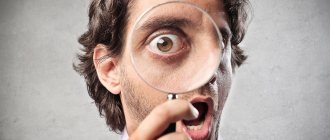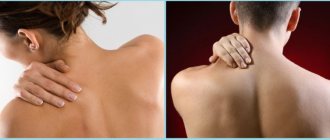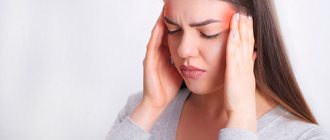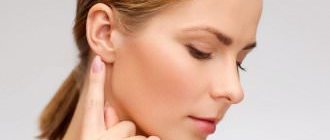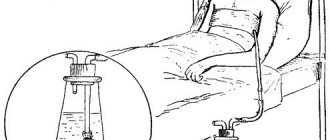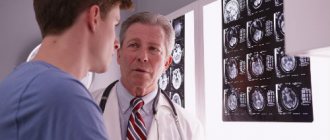Most often, the burning sensation is localized in the back of the head (less often in the frontal part), but it can also be in half of the head, over the entire surface, squeezing the head in the form of a hot hoop, radiating to the neck, back and chest.
Patients who describe this symptom report a feeling as if they had been “poured with boiling water,” “put mustard plaster on,” or heated with something.
At the same time, no pathological changes are detected at the site of this sensation: the skin is normal, no pain is observed when palpating it, no inflammation or destruction is observed in the underlying tissues.
A burning head may be accompanied by insomnia, anxiety, dizziness and headaches, palpitations and decreased appetite.
The mechanism for the development of a burning sensation is associated with overexcitation of brain structures responsible for supplying pain and tactile sensitivity to the skin.
What pills are best to take if you rarely get headaches?
Any painkillers
will one way or another have pathological consequences. The active ingredient diclofenac affects the stomach, meloxicam - the liver, ibuprofen - the cardiovascular system. Everything has a side effect, but if you take anti-inflammatory pills rarely, nothing bad will happen.
combination drugs :
they include not only the anti-inflammatory substance itself, but also caffeine, phenylephrine, antispasmodics... Such drugs work more complexly and it is better not to use them without the supervision of a doctor. Otherwise, situations arise when a patient without migraine takes pills for migraine, receiving a side effect from them.
Uncontrolled reception
drugs can lead to abusive headaches.
They occur when you take excessive amounts of anti-inflammatory pills. Let’s say you take pills every day according to the scheme “I have a headache - I took a pill - the pain went away - the next day it hurts again - I took a pill”... As a result, your head starts to hurt simply because you need to take an anti-inflammatory drug again. This situation requires treatment
with a specialist.
Prevention methods
According to statistics, adults often have headaches due to acquired disorders. Common causes are poor diet, stress and lack of rest, and excess weight. Today, many people, including young people, lead a sedentary lifestyle, which also negatively affects the general condition of the body. Doctors at the Clinical Institute of the Brain have several tips on how to provide timely prevention of headaches at home:
- regularly measure blood pressure, especially at the age of 40 years or more;
- perform simple exercises for the neck and head every day, including during the working day;
- consume sufficient amounts of vitamins and microelements;
- give up bad habits, smoking and drinking alcohol, as well as fatty foods high in cholesterol.
If a person has a headache for several days or even weeks, it is worth contacting the Clinical Brain Institute. Doctors will develop an individual program for diagnosing and treating chronic pain. The scheme will include only the necessary informative techniques that will allow you to quickly make an accurate diagnosis and select the most effective course of treatment, including at home.
Is it possible to prevent headaches?
To prevent pain caused by muscle tone, neck exercises help. Alexey Malkov recommends the Shishonin method
- these are simple exercises that can be found on the Internet. They take about 20 minutes to complete. According to the doctor, they cannot cause harm.
Also from the recommendations: sleeping on an orthopedic pillow ,
regular
massage of the cervical-collar area
.
For those who work at a computer, two more tips: get distracted every two hours and do short exercises for your neck ,
and once a week try to change the position of the screen (move from the left to the right side of the table and back). The latter will prevent you from developing a “chronically forced posture.”
Additionally, the neurologist advises avoiding excessive consumption of caffeine and alcohol, and quitting smoking to reduce the risk of vascular pathology. If headaches are chronic, you can take magnesium
(courses twice a year, according to the instructions), vegetative correctors and venotonics for prevention (also according to the instructions).
You can make an appointment with Alexey Malkov or another neurologist by calling the center: +375 29 311-88-44 ; +375 33 311-01-44 ; +375 17 299-99-92 .
Or through the online registration form
on the website.
Causes of heaviness in the head
Physiological factors
The most common causes of heaviness in the head are fatigue and lack of sleep.
Your eyes get stuck together, you want to quickly put your head on the pillow and fall asleep - this situation is typical for overwork. Symptoms that develop periodically after exercise usually do not pose a threat to a person. After a good sleep, the discomfort disappears. When such violations bother you too often, you should pay attention to your health status. Heaviness in the head occurs in many people under the influence of sea motion. Seasickness is diagnosed in every third adult and is manifested by dizziness, a feeling of “fog in the head,” and nausea. In most cases, symptoms are mild and can be managed without medication. Heaviness with pressing pain in the head also occurs with motion sickness in land transport.
Tension headache
This type of cephalalgia is sometimes manifested not by classic pressing or squeezing pain, but by heaviness in the head. The symptom occurs some time after waking up and may disappear after a few hours or last the whole day. Unpleasant symptoms are of moderate intensity and are not combined with acute pain or dizziness. In strength and character, the heaviness is similar to the feeling of a hoop squeezing the head.
Arterial hypertension
With high blood pressure, heaviness is observed in the occipital area of the head, which is aggravated in a lying position, when bending over, or straining. Discomfort becomes more noticeable during physical activity and stress. If the patient does not follow the recommendations for taking medications, does not control blood pressure, heaviness in the head bothers him every day. The spread of discomfort to the frontal area and the appearance of sharp pain is a sign of an incipient hypertensive crisis.
Heaviness in the head
Infectious processes
Most bacterial or viral infections in the prodromal period are manifested by low-grade body temperature, which provokes heaviness in the head. Symptoms are complemented by moderate pain in the joints and muscles, and drowsiness. Patients describe their condition as malaise or weakness. After 1-2 days, when the full picture of the disease unfolds, the severity is often replaced by classic cephalgia.
ENT diseases
The appearance of heaviness in the head during inflammatory otolaryngological pathologies is caused by general intoxication and malaise, accompanied by an increase in temperature. The symptom can occur with more serious damage to the organ of hearing, which is due to the spread of the process to the vestibular analyzer. Severity is usually accompanied by dizziness, nausea, and lack of coordination. The main ENT causes of discomfort:
- Sinusitis.
Heaviness in the frontal zone is observed with frontal sinusitis or ethmoiditis, which is associated with the accumulation of inflammatory exudate in the paranasal sinuses. Symptoms intensify when the head is tilted forward and pressure is applied to the bridge of the nose. The patient is also concerned about nasal congestion, mucopurulent discharge, and fever. - Eustachite.
Heaviness in the head in those suffering from inflammation of the auditory tube is due to the involvement of the structures of the middle ear in the process. In addition to this symptom, the patient complains of noise and ringing in the ears, and notices hearing loss. A pathognomonic sign of eustachitis is a feeling of resonance of one’s own voice. - Meniere's disease.
The disease is characterized by paroxysmal heaviness in the head, occurring simultaneously with dizziness and episodic unilateral loss of hearing. The patient experiences a feeling of rotation of surrounding objects or a feeling of “sinking” of his own body.
Pathologies of the cervical spine
Damage to the vertebrae or neurovascular structures located in this area is a typical cause of heaviness in the head in middle and older age. Symptoms appear against the background of osteochondrosis and cervical spondyloarthrosis. Patients complain of heaviness and dull pain in the head, which is accompanied by pain in the back of the neck. When making sharp turns or staying in an uncomfortable position for a long time, the pain becomes shooting, burning.
Paroxysmal heaviness in the back of the head, headaches and impaired coordination of movements develop with vertebral artery syndrome, which occurs as a basilar migraine. Occasionally, heaviness in the head is caused by congenital structural anomalies - Klippel-Feil syndrome, platybasia, basilar impression. In this case, symptoms mainly manifest in childhood.
Neurasthenia
A painful heaviness in the head that begins at the end of the day is a characteristic manifestation of asthenic neurosis. Patients experience an unpleasant feeling of pressure on the head from all sides, as if they were wearing a heavy and tight helmet. The clinical picture is complemented by dizziness. Its peculiarity is that surrounding objects seem motionless to a person, and rotation occurs “inside the head.”
In addition to physical symptoms, emotional disturbances are noted. Patients are characterized by increased nervousness, irritability and excitability. They react negatively to extraneous noise, loud speech, and large crowds of people. The patient feels that being around strangers makes the heaviness in his head intensify. Characterized by difficulty falling asleep, frequent awakenings at night and disturbing dreams.
Rare causes
- Withdrawal syndrome:
after using drugs, alcohol. - Intoxication
: heavy metals, organic solvents. - Polycythemia.
- Injuries
: concussion or contusion of the brain, subcutaneous hematoma in the scalp.
Treatment
Help before diagnosis
To eliminate heaviness in the head, a positive emotional attitude is of great importance. It is necessary to protect yourself as much as possible from stress and external irritants, normalize your daily routine, and not overwork yourself at work. Doctors advise establishing a drinking regime and limiting coffee consumption to 1 cup per day. Regular walking before bedtime, fortified meals, and a change of environment help reduce signs of neurasthenia.
Self-administration of painkillers to relieve heaviness and pain in the head is the wrong approach, since the symptoms manifest themselves in dozens of different diseases. Trying to eliminate discomfort, the patient does not solve the problem, so there is a risk of disease progression and complications. If heaviness in the head is accompanied by nausea and vomiting, visual and hearing impairment, this is an indication for emergency medical attention.
Conservative therapy
To eliminate heaviness in the head associated with tension cephalgia or neurasthenia, psychotropic medications are recommended. Antidepressants - selective serotonin and norepinephrine reuptake inhibitors - have a good effect. Additionally, muscle relaxants and sedatives are prescribed. To remove symptoms, restorative treatment is carried out with calcium glycerophosphate and hopantenic acid.
If the cervical spine is affected, tablets of non-steroidal anti-inflammatory drugs are taken, injections of chondroprotectors and B vitamins are given. To quickly relieve discomfort, ointments with an analgesic and warming effect are indicated. If the pathology is accompanied by vertebral artery syndrome, therapy is enhanced with neuroprotective drugs and medications that improve cerebral circulation.
For neurasthenic cephalgia and heaviness in the head, physiotherapeutic treatment is effective. Reflexology, aromatherapy, and electrosleep are effective in normalizing the functioning of the nervous system. To get rid of symptoms of cervical osteochondrosis, electrophoresis with drugs, magnetic therapy and electroanalgesia are used. ShVZ massage and manual therapy are performed strictly as prescribed by the doctor.
